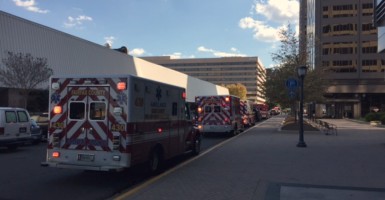Police cars, fire trucks, and ambulances converged at my office complex. As I stood in awe with my colleagues, someone said “There’s an active shooter in the building over there!” In disbelief I searched Twitter for clues.
I found one tweet:
Report of active shooter on 5th floor of skyline complex on Rt.7 in Fairfax…in Deloitte Offices.
— JamesMcLean (@outcold1) October 15, 2015
Jeez, this could be bad. As I scoured social media, more emergency responders arrived. A motorcade-worthy array of police motorcycles zoomed by and a half-dozen ambulances lined up along the street. This was getting serious. Soon the Fairfax County Police Department confirmed there was an active incident via Twitter:
We are investigating a report of shots heard at 5109 Leesburg Pike. Nothing confirmed. No suspect, no victims located at this point.
— FairfaxCounty Police (@fairfaxpolice) October 15, 2015
The police department followed up with a couple more tweets stating that they were continuing to investigate the situation.
Meanwhile, I was receiving tweets from individuals sheltering in place who were understandably very worried. One individual contacted me after seeing on of my tweets about the situation. She said: “SSA BUILDING AND GARAGE ON LOCK DOWN. NO ONE CAN LEAVE OR ENTER. WE ARE REAL NERVOUS.” I imagined that this person was hiding under her desk or in a closet, petrified. I copied the police department’s tweets and passed that info along.
And then this from the police department: “Information NOW CONFRIMED is that 5109 Leesburg Pk was the scene of an Active Shooter DRILL.” Having participated in numerous exercises, as both a federal homeland security official as well as a first responder, I knew that the police department must have been blindsided by this new information.
The response I had earlier witnessed was a real-world response, not a fictional one. Sure enough, the local news soon reported: “Fairfax Co. police not notified of drill, respond to reports of shots.”
Since an after action report should always follow an exercise, I will share three of my observations.
- This incident shows the power of social media to rapidly spread information, and misinformation. Re-tweets quickly multiply reports—agnostic whether it is fact or rumor. The Fairfax County Police Department did a good job sharing the facts. Individuals at the incident site tweeted what they saw and how they felt, others tweeted rumors. Social media thus provides “situational awareness” to everyone, but it is up to the reader to determine the veracity of the information.
- For the responsible party to not properly notify local authorities and employees that an active shooter drill was scheduled is both astonishing and reckless. As the tweets during the incident suggest, people were worried—even panicked—and rightly so. How would you feel if you thought someone with a gun was shooting in your building and that you could be next? After word spread that this was a drill, those affected were stunned. Said one, “would have been nice to tell terrified employees it was a drill.”
- Just because this drill was bungled, does not mean we should abandon active shooter exercises. Employers and building managers should develop comprehensive active shooter plans that include an exercise component. Exercises provide individuals an opportunity to test what they learned in training programs and provide emergency managers the ability to update and refine their plans. But please remember to notify employees and local authorities in advance. An exercise, after all, should be a learning experience, not a traumatizing one.


























